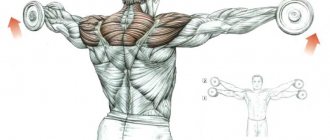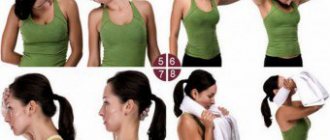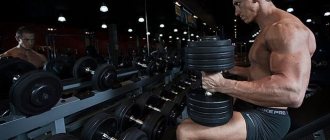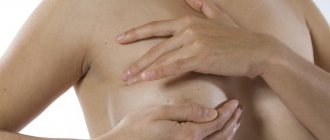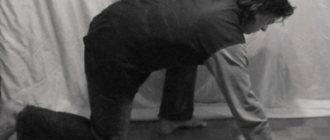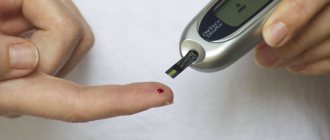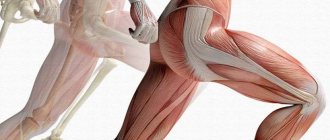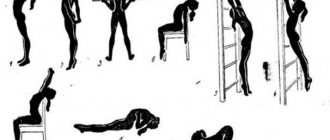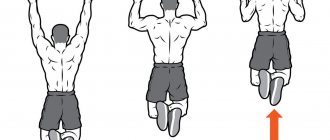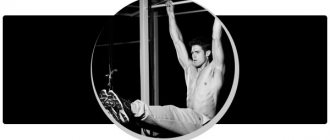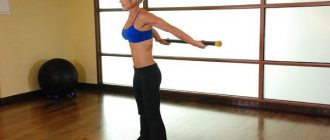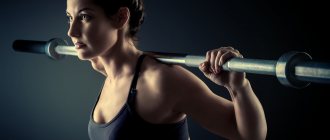Deadlift
Whether or not to include this exercise in your training is up to everyone, but you don’t have to use it to build your back.
Performing the exercise:
- Take the starting position, holding the barbell shoulder-width apart, do a small squat, bending your knees, move your pelvis back, and keep your back strictly straight and fixed.
- As you inhale, lift the barbell along your legs. First, you straighten your legs, bringing them into a straight position, and immediately complete the movement with your back, straightening your lower back and bringing your whole body into a vertical position.
- Then lower the bar along your legs by stretching the back extensor muscles. As soon as you touch the floor, repeat the movement.
- Having completed the required number of times, carefully place the barbell on the floor, taking the starting position.
Nuances and variations:
There is one effective variation of this exercise - the deadlift with dumbbells, but in a strength sense it will lose its advantage.
This movement must be performed strictly technically, because
It's a very difficult movement and it's very easy to get injured.
Before performing this exercise, pay attention to warming up.
This movement includes working not only the back, but also the legs, because at the beginning of the movement the lifting occurs due to the legs. To exclude your legs from the movement, perform the exercise in the negative phase up to the level of your knees, then you will perform it only at the expense of your back.
Perhaps we will stop at this list; of course, there are still a lot of movements and exercise machines that allow you to work your back muscles, but all of the above are classics and the basis for building a powerful V-shaped back.
It is not necessary to cram all the movements into one workout; create your own program of 3-5 movements and work with them for 2-3 months, then change or alternate from training to training. May the power of testosterone and willpower be with you, friends! Good luck!
Stereotypes about bodybuilders
What you need for a flat stomach besides training your abs
Exercise bike training for weight loss and endurance
The basis of good nutrition is a proper breakfast
How to properly perform push-ups?
Warming up before training is the key to successful training
Exercises for scoliosis
Scoliosis can be congenital or acquired (due to curvature of the spine and incorrect position of the spinal discs). At the initial stages, self-correction is quite possible, for which special, fairly simple exercises are selected. At later stages, self-medication is not recommended, and only a doctor can select exercises and the degree of load based on the condition of his patient.
We will look at a small complex for the back muscles for scoliosis in the initial stage.
- Sit on the floor, bend your knees and pull them up to form a right angle. Stretch your arms out in front of you to maintain balance. Pull your legs towards your chest and lean back slightly, keeping your back and abdominal muscles tense. Repeat the springy movements of pulling your knees to your chest at a comfortable pace 10 times. Take a break and repeat 3 times.
- Take a regular rolling pin or fill a 1.5 liter plastic bottle with warm water. Lie on your back and place a device under it. Raise your pelvis and slowly, moving your legs back and forth, roll the rolling pin or bottle along your back from the lower back to the neck several times. The process must happen slowly.
How to strengthen your back muscles at home
It is better to do physical exercises to strengthen your back under the supervision of a professional trainer in the gym, and if you are worried about pain in the back, it is even more necessary to consult a doctor who will prescribe individual exercise therapy to strengthen your back muscles. But the modern pace of life does not always allow you to find time for this, so sometimes it is easier to do them at home.
Strengthening exercises for the spine typically target only two of the seven major back muscles, namely the latissimus and rhomboids. This is quite enough, since the rest do not play a big role in maintaining an upright body position and, accordingly, getting rid of lower back pain.
Preparing for back muscle training
Exercises to strengthen the back muscles must begin with a warm-up. This will take 5 minutes, but the risk of stretching is significantly reduced. Stand straight with your feet hip-width apart. Perform each step for about half a minute.
- Inhale air with your stomach through your mouth - hold your breath for a couple of seconds - exhale all the air through your nose;
- Rotational movements of the shoulders, first together, then alternately;
- Stretch your neck muscles by tilting your head up and down and from side to side;
- Alternately swing your arms up and back;
- Raise your hands up in the “lock”, lean first to the right, then to the left;
- Rotate your hips (imagine twirling a hoop);
- Bend down, touching your legs with your hands, then straighten up, bending back a little;
- Walk in place, raising your knees high, help yourself with your hands;
- Running in place;
- Finally, take a deep breath and exhale completely.
https://youtube.com/watch?v=1U-kUu5ctvI
You may like: fish back exercise
A set of exercises to strengthen the back muscles
- Standing, pull yourself up on your toes, pull your arms up and pull your stomach in tightly. Now slowly lean forward, grab your ankles with your hands, trying to “fold” more tightly. Then slowly unbend, taking the starting position.
- Stand straight, feet together, cross your arms over your chest (palms on your shoulders). Bend forward, bending well, then straighten again. Then stretch your arms forward, lean forward low and slowly straighten, then fold your arms crosswise on your shoulders again.
- Feet shoulder-width apart, from a standing position, back as straight as possible, keep your body straight, arms free at your sides. Do a squat, back to the starting position. Then lean forward, swing your arms wide back, make a deep backbend and extend your arms straight out in front of you. Then take the starting position.
- Spread your legs wide apart, bend forward low, and arms down. Swing your arms so that they can move them further behind you. Next, you need to stretch your arms forward and bend so that you touch the floor as far in front of you as possible.
- Get on your knees, stretch your arms out in front of you. Bend forward and down until your hands touch the floor. Jerk your arms apart, swinging them in different directions, and return to the starting position by pushing your arms off the floor.
- “Walking” with your hands: while on all fours, without moving your legs, move your hands to the left and back. On the right side - the same.
- Lie on your stomach and stretch your arms straight forward. As you rise, bend back, placing your palms behind the back of your head. When returning to the starting position, extend your arms forward.
- Lying on your stomach, clasp your bent arms under your forehead. Bend your forearms to the maximum. Pull your toes and slowly lift your legs off the floor, alternately swing up and down and slowly lower them back to the floor.
- Roll over onto your back and bend your knees, placing them hip-width apart and pressing your feet firmly into the floor. The arms lie relaxed along the body. Lifting your pelvis high off the floor, lift your hips up, hold this position for a few seconds and slowly lower back to the floor.
- Sit down on the mat and bring your legs together. Bend your right leg closer with your knee to your stomach and move your arms up and back, make forward movements without changing the position of the bent leg. Afterwards, lean forward deeply and try to reach your left toe with your hands. Repeat the exercise in mirror. At the end of the session, repeat the warm-up.
Exercises to strengthen the spine are best done in the morning or evening before bed.
Be sure to read: hyperextension for the back
How to pump up a wide back
The best exercise for developing a wide V-shaped back (or as it is also called: herringbone-shaped back) is definitely. The main trick is that in addition to pumping up the muscles, wide-grip pull-ups also stretch our collarbones. This is no longer just a blow to genetics (from the skinny to the athlete), it is already an effect on your skeleton. Cool, yeah?
In addition, during the actual pull-up, the outer shell of the muscle tissue of the latissimus muscles contracts. And using one of these two methods:
- Slow descent with a pause at the bottom point;
- Lowering with additional weights (for example, a friend hangs himself on his feet),
It turns out to get an additional increase in the mass of the latissimus due to the compaction of the muscle membrane. It would be good to periodically practice both options - this will give maximum results.
Specifics of activity disorders
In some cases, one part of the muscle becomes weak. In such a situation, another department takes on double the workload. Trying to compensate for the incapacity of the other part, the fibers try to hold the scapula. As a result, it shortens and pain begins. Most often, the rhomboid muscle weakens completely. Being in an uncomfortable position, a person tries to straighten up. But he does this not due to the work of the extensors that fix the scapula. The back is straightened due to the activity of the muscles in the back area. As a result, hyperlordosis develops. It represents a strong lumbar deflection.
Rhomboid muscle exercises for men with their own weight
Let's take a look at how to properly do the exercises that our bodyweight training program
. For clarity, we present animation and photos of exercises. You will find step-by-step instructions for performing them on the corresponding pages with descriptions of specific exercises.
Pull-ups on the bar
excellently work the rhomboid muscles. Among the basic variations of the exercise, you can use pull-ups on a horizontal bar with a regular grip.
Wide-grip pull -ups have proven to be excellent for working the rhomboid back muscles.
. In addition to the rhomboid, wide pull-ups work the latissimus, lower trapezius, and rear deltoids.
A simple and basic version of the exercise for beginners would be a wide-grip pull-up with bent arms.
.
Among the advanced options, it is worth highlighting wide-grip pull-ups to the chest
, as well as
behind the head
. The second option, in addition to the execution technique itself, is characterized by increased complexity.
Another advanced way of doing pull-ups is using a straight, narrow grip.
. Narrow pull-ups stimulate not only the biceps, but also the shoulder, back and pectoral muscles (primarily pumping the brachialis, latissimus, teres major, serratus anterior, trapezius and rhomboid muscles), so they are also suitable for back training, making up a solid and unified set of exercises.
When performing pull-ups on the horizontal bar, try to use your back muscles more, without allowing excessive tension in your arms. Also, the correct pull-up technique involves ensuring that there is no swaying. For greater results from exercises of this type, when performing them, bend your back and try to look up.
Dips are also suitable for training the rhomboid muscles.
. For this basic exercise with normal difficulty, you will need a narrow version of the parallel bars, which can be found on a well-equipped sports ground. The parallel bars exercise is considered one of the best exercises for the triceps, but it also targets the pecs, anterior deltoids and rhomboids, adding flexibility to the entire shoulder girdle. When performing this exercise for posture, try to keep your shoulders compact and straight - they should not twitch, maintaining a stable state. The back is in a straight position with the spinal column as straight as possible. We perform push-ups on parallel bars slowly, watching the technique of movements and not allowing relaxation when lowering to the lowest point.
Plank
– a basic type exercise with normal difficulty, which is recommended to be used as a final exercise during training.
Fits perfectly into home training and exercises using your own weight. We offer two plank options - with emphasis on bent arms
and
on outstretched arms
. Since the exercise is static, you only need to correctly take the starting position and stay in it for some time. We place emphasis while lying on straight arms or with elbows bent at right angles. We carefully control the lack of body movements while performing this exercise to train muscles. We keep our back straight, without allowing it to round or sag - the spine should be in the most straight position. Keep the pelvis in a neutral position. The shoulder blades should be slightly brought together and the chest should be straightened. We also monitor our breathing so that it continues to be natural, without delays or interruptions.
The plank helps balance the work of different muscle groups of the body, increases the endurance of the stabilizing muscles with an emphasis on the abdominal muscles, muscles of the trunk, shoulders, shoulder blades and arms. Thanks to this effect, the plank can significantly contribute to the cessation of painful sensations in the back. You can start doing planks with 10-second approaches, gradually increasing their duration to a minute or more, depending on the level of preparation.
Thus, we looked at how to properly pump up the rhomboid major muscle using only your own weight, exercises for which our Non-Lazy Sloth recommended to you. Using the information offered on our website How to Pump Up. About, you will be able to understand the intricacies of training both with your own weight and with strength loads. We provide detailed information for men and women on what exercises to do for each muscle group, as well as many training tips.
Problems
The rhomboid muscle is prone to weakness, usually on both sides at once. In such cases, the shoulders shift forward, resulting in stooping. When the fibers are weak, the pectoralis minor muscle begins to shorten. This allows for even greater shoulder displacement. The pectoral muscle in a shortened state can put pressure on the neurovascular bundle. Because of this, there is a feeling of goosebumps in the hands. Another sign of shortening is the rotation of the hands with the back area forward in a standing position with the upper limbs lowered. A weakened rhomboid muscle will also displace the scapula, and subsequently the entire shoulder girdle. Following it, the neck and head will move forward, since the extensor muscle is the first to attach to the upper vertebrae of the thoracic region. Due to muscle weakness, it cannot function normally.
Exercises for back thickness
Technical secrets
The best exercise is the bent-over row of a barbell or dumbbell. With a strong tilt, the latissimus muscles are loaded more, and with a high stance, the trapezius works more. Use these variations depending on your purpose.
The main secret is to start the movement by bringing the shoulder blades together and tightening the target muscles. Fully bring your shoulders together and then lift the apparatus. Always hold the weight at the top using muscle strength.
Avoid inertia and cheating unnecessarily. The only reason is working with heavy weights. Do not engage your arm muscles and try to lift the weight by abducting your elbows.
Diagnostics
When muscle activity is disrupted, pain occurs. They are localized in the area of the scapula, along its inner edge. However, pain does not always occur when moving. It can often be felt at rest. It is worth noting that more than one rhomboid muscle is involved in the formation of pain. However, to feel it, it is necessary to eliminate stress points in the infraspinatus, trapezius fibers and the structure responsible for raising the shoulder blades. If crunching, clicking, or pain occurs when moving the latter, this may indicate a malfunction of the rhomboid muscle. An accurate diagnosis must be made by a doctor. Experts do not recommend delaying visiting a doctor.
Rhomboid back muscles
They belong to the superficial ones, along with the latissimus, trapezius, serratus, and levator scapulae.
Where are they located: near the shoulder blade, under the trapezius muscle.
Functions: brings the scapula closer to the ridge and lifts it.
Exercises for development: almost anything that involves the upper back.
For example:
- barbell pull to chest;
- pull-ups (different-grip pull-ups are good);
- dumbbell row;
- swimming.
With regular exercises for the rhomboid muscles of the back, the muscle relief is clearly visible: the rhomboid muscles seem to “raise” the trapezius, creating more volume. The thoracic spine is also strengthened.
Obliques of the back
In fact, it is more correct to call them oblique abdominal muscles or oblique abs. But they also come out on the back. Unfortunately, the oblique muscles are often forgotten when training both the back and abdomen, but in vain.
After all, they provide not only support for internal organs (in cooperation with the abs) and a slim figure, but also correct posture.
Where they are located: on the sides of the body, from the lower abdomen to the chest.
Functions: turns the body, bends to the sides, lifts the pelvis with fixed shoulder blades.
Exercises for development: various twisting movements and bending.
It can be:
- “woodcutter” - swings with closed arms diagonally (up to the right - down to the left and vice versa), possibly with weights (with a kettlebell or on a machine);
- lying body twisting (bent knees are placed alternately on one side and the other with the shoulders not coming off the floor);
- lateral “plank” (emphasis on one arm), lowering and raising the pelvis in this plane;
- squats with twisting of the upper part of the body, hands behind the head;
- various lateral tilts.
Exercises for the oblique muscles of the back (abs) should be given more attention to those who want to have a slim waist: even a few minutes of training a day will give visible results very quickly! Oblique abs quickly become toned and tighten the contours of the body, so that the waist becomes more expressive.
Another advantage of the oblique press in relation to the figure is that massage has a very noticeable effect on it. Probably, many have at least once twirled a hula hoop (regular or massage, with spikes or rollers).
It just stimulates the oblique abs (well, and the abdominal ones, of course, too). But few people know that even with a regular massage, you can influence the lateral surfaces of the body in such a way as to “make a waist”: the massage therapist stimulates the oblique muscles with special “sawing” and other movements, and you get up from the massage table with a defined waist! Here is an exercise option for the lazy.
Remember to perform relaxation techniques at the end of each workout. At least just stretch, hang on a horizontal bar, lie down on a flat surface, and do breathing exercises.
We develop everything at once
Do not forget that developing only certain muscle groups is inappropriate. Create a set of exercises that involves your entire body. If, for example, you decide to seriously work on your back to eliminate the consequences of a sedentary lifestyle, remember: good abs are also important to support the spine.
And you won’t be able to do some exercises to train your back muscles if you have weak arms or legs. So you need to take care of yourself “in all respects”!
Yoga works very well in this regard. In it you will not find exercises designed only for the back muscles or the same abs; Yoga asanas (postures) force the whole body to work, muscles that you never knew existed are tensed.
Swimming is also one of the most harmonious sports in which the whole body works. Of course, the hands are very actively involved, but everything else is also in good shape. Swimming is especially beneficial for the spine, so swimming is recommended for anyone with back problems.
Dancing, gymnastics, aerobics, and martial arts are also excellent choices.
Spend time on your health, spend it on gyms and swimming pools, so you don’t spend it on hospitals later!
Causes of pain
Excessive stress on the rhomboid back muscle can lead to malfunction. This phenomenon may be accompanied by spasms and pain of varying intensity. In addition, excessive tension in muscle tissue can lead to limitation of motor functions of the shoulder region and cervical region of the body.
Excessive load on the rhomboid muscle can occur due to improper carrying of loads, sudden movements or playing sports.
The cause of overload of the rhomboid muscle is often excessive physical stress on the upper limbs and shoulder area, namely:
- upward movements of the arms directly above the head. These can be loads when a person places something heavy on a surface high from the floor, or when serving in tennis;
- constantly wearing a heavy backpack or bag on one shoulder;
- movements during rowing;
- lifting heavy objects using improper technique.
How to lift weights correctly?
As a result, the rhomboid muscle, which is constantly in good shape, weakens, which entails a change in the location of the shoulder blades. This occurs due to a series of muscle changes called upper crossover syndrome.
Another problem with the rhomboid muscles is overstretching them. This occurs as a result of the shoulder part of the back being constantly lowered. A clear result of this process in the back muscle tissue is stooping. Here there is strong passivity of the rhomboid muscle. In addition, when the back muscles are stretched, a process of shortening of the pectoral muscles opposite in location is also observed.
Also, a large stretch of the rhomboid muscle can be observed in people with tall stature. Sometimes, due to their internal complexes, they try to look shorter, and for this they constantly slouch, which ultimately leads to problems with the back muscles. A constantly bent position of the torso, namely the tension of the rhomboid muscles, provokes muscle spasm.
Main complex
The gradual increase in strength training is carried out in two ways: extensive and intensive. The extensive path involves an increase in the total number of movements. The intensive method involves the use of auxiliary devices.
Universal exercises without machines
These classes can be carried out at home or on nearby sports grounds:
- lifting the body from a lying position with fixing the legs;
- pull-up with a wide wrist grip;
- pulling up by the head;
- push-ups with the widest grip possible.
Such elementary techniques are part of standard sports training complexes. For beginners, it is recommended to increase the frequency of movements over a fixed time, for example, within 1 minute. Sufficient physical fitness allows you to begin quantitative approaches.
Exercises with weights
To develop the rear part of the body, weights reduced by 10–20% are recommended, the emphasis is on the completeness of the exercise. Too heavy weights reduce the range of motion and create constant muscle tension.
At the end of the exercises, the muscles should be pleasantly tired, pain is unacceptable. Overload, such as stress, must be short-lived, otherwise its positive impact is lost. To put it in simple terms, do everything you can and then a little more.
Using a variety of weights (vests, belts, cuffs), you can build muscle mass in a short time, reducing the speed of execution, while simultaneously increasing concentration on the working muscle.
- Pull-ups with weights from 5 kg. Wide straight, reverse grip “behind the head” - for the back muscles, narrow - for the chest.
- Rotations of the body with dumbbells extended forward/arms with weights.
- Lifting - lowering dumbbells/arms with weights in the lateral plane
- Bent-over rows.
- Torso bends.
- Shoulder shrugs (shrugs) with a barbell or dumbbells; a curved neck will help avoid some inconveniences
- Deadlift. In the phase of gaining muscle mass and increasing strength, this is certainly one of the most necessary exercises.
You also need to pay attention to your breathing while performing the action. Inhale - tension, exhale - relaxation, mentally direct energy into the muscle group being trained
The greater the weight, the more important the technique of performing movements.
Exercises for back width in the gym
For back strength training, which should be done regularly two to three times a week, you will need special equipment.
- Vertical block trainer. “Pullover”, rows with a wide and reverse grip. It is the reverse grip that maximally develops the latissimus muscles, giving the body the desired V-shape.
- T-bar. Traction in the safest mode.
- Horizontal block exercise machine. Traction similar to the movements of rowing athletes.
Number of repetitions
1) For relief and burning fat – the weight should be such that in 1 approach you can do a maximum of 14-12 repetitions;
2) To gain muscle mass , set the weight so that no more than 10-8 repetitions are done in 1 approach without breaking technique;
3) To increase strength indicators , you will have to take heavy weights, there is a serious load here, if necessary, use wrist straps and an athletic belt, the weight should be so large that no more than 6-4 repetitions are done in 1 approach.
Watch this video on YouTube
Exercises for rhomboids
Below are exercises that involve the rhomboid muscle.
Lower block row to the waist while sitting
This exercise will allow you not only to increase the mass of your back muscles, but also to “draw” them.
Working muscles:
- Diamond-shaped
- Lat
- Middle and lower trapezius
- Rear delta
Exercise technique:
Sit on the seat. Take the handle in your hands and rest your feet on the stops. Knees slightly bent. The body is vertical. There is a deflection in the lower back. As you inhale, lean forward slightly with your lower back arched. As you exhale, pull the handle toward your lower abdomen, returning your torso to an upright position.
Important details:
During the exercise, you should actively move your shoulders back and squeeze your shoulder blades together as much as possible. The elbows go along the sides along the body. It is with this technique that the muscles of the upper and lower back will work as much as possible.
Upper pulley to chest
This exercise imitates pull-ups on a horizontal bar and will allow you to effectively work out the latissimus muscle and use the rhomboid muscle.
Working muscles:
- Lower trapezius
- Rear delta
- Diamond-shaped
- Latissimus
Exercise technique:
Take the handle of the exercise machine with a straight wide grip and sit on the seat. As you exhale, pull the handle toward your upper chest, slightly tilting your torso back. As you inhale, return to the starting position.
Important details:
As you row, push your chest out to meet the movement of the handle. The shoulders should move back and down, the shoulder blades should be brought together. Pay very close attention to the technique so that exactly the muscles that are supposed to work, namely the back muscles.
Pull-ups on the horizontal bar with a straight wide grip
An excellent exercise for training the rhomboid muscle on any sports field.
Working muscles:
- Rear delta
- Diamond-shaped
- Lower trapezius
- Latissimus
Exercise technique:
Grasp the bar with an overhand grip, much wider than shoulder width. Without straining your biceps and squeezing your shoulder blades, pull yourself up, trying to touch the bar with your upper chest. Pause a little at the top and return to the starting position.
Important details:
When pulling up, bend your back and look straight up.
Bent-over barbell row
One of the most effective exercises for pumping the latissimus muscle and engaging the rhomboid muscle.
Working muscles:
- Trapezoidal
- Diamond-shaped
- Latissimus
- Rear delta
Exercise technique:
Grasp the barbell with an overhand grip, slightly wider than shoulder-width apart. Bend your legs slightly and lean your torso forward. The tilt should be significant, with the torso almost parallel to the floor. Arms straight. There is a deflection in the lower back. Inhale, and as you exhale, powerfully, while remaining bent over, pull the barbell until it touches your lower abdomen. As you inhale, slowly return to the starting position.
Important details:
At the top of the movement, move your elbows and shoulders back as far as possible and bring your shoulder blades together.
Options:
The T-bar row is almost identical to the bent-over barbell row, except that one end of the bar is attached to the floor or frame of the machine. As a result, it is possible to achieve less harmful tension in the lower region of the spine.
Bent-over dumbbell row
An excellent basic exercise for developing the central and upper back.
Working muscles:
- Latissimus
- Diamond-shaped
- Trapezoidal
- Rear delta
- Biceps
Exercise technique:
Place your left knee on the bench. Then bend over and place your hand on it. The body is almost parallel to the floor. There is a deflection in the lower back. The right foot is on the floor. With your right hand, hold the dumbbell with a neutral grip. As you exhale, pull the dumbbell to your lower abdomen by contracting your back muscles. As you inhale, slowly lower the dumbbell to the starting position.
Important details:
Try to perform the movement using your back muscles, not your arms. To do this, raise your elbow high and do not move it too far to the side. Keep your back horizontal and don't round it. Don't rotate at the waist. It is in this position of the body that the back muscles are maximally used.
Abdominal thrust while sitting on a machine
Abdominal rows on the machine combine well the strength load with the safety of the workout.
Working muscles:
- Rear delta
- Trapezoidal
- Diamond-shaped
- Latissimus
Exercise technique:
Sit on the seat of the exercise machine and rest your feet on the supports. As you exhale, pull the handles of the exercise machine towards your stomach, straightening your chest and moving your elbows back. As you inhale, slowly return to the starting position.
Important details:
Do not use inertial force. Movements should be slow and controlled.
Prerequisites
The rhomboid muscle is susceptible to weakness, especially in cases where there is overwork/strain of the pectoral muscles. This problem often occurs among bodybuilders. The pectoral muscles have a beautiful relief, but when they are overworked, the muscles of the upper back weaken. As a result, many bodybuilders walk with a slouch. The force of the overloaded pectoral muscle pulls the shoulders forward, and the progressive tension of the rhomboid fibers is weakened. As a result, pain areas appear. Any job that involves bending forward puts the rhomboid muscle at risk.
Anatomy of the back muscles and their functions
The back muscles are in second place in size after the legs, so, of course, back training should be intense and at the same time voluminous.
The back muscles occupy the entire area from the neck to the pelvis, there are many of them and they are divided into two types:
- Deep (those muscles that we cannot see).
- Superficial.
For us, the most important ones are the superficial muscles of the back - these are those that we can see:
- latissimus wing muscles;
- trapezius muscles;
- back extensors - pillars.
The function of the latissimus muscles is to bring the arm to the body and rotate it inward - pronation. Pulls the body towards the arms fixed to something (crossbar, ledge) due to the strength and contraction of the latissimus muscles.
It has the shape of a triangle and is divided into three parts:
- The upper part takes up the position from the neck and passes to the shoulder joint along the collarbone.
- The middle part is located between the shoulder blade and the spine.
- The lower part is located below the shoulder blade and is a continuation of the middle part.
The function of the trapezius muscle is to force the contraction of all parts to bring the scapula closer to the spinal column, as well as to lift the scapula up and down.
The function of the extensors is to straighten the spinal column and hold the torso in an upright position. Tilts the spinal column, to the right or left, depending on unilateral muscle contraction. Participates in the breathing process by lowering the ribs with part of their bundles.
Thus, we conclude that the back muscles are quite massive and most of them are occupied by three groups (the latissimus, trapezius and extensors), the development of which will create the basis of a beautiful and large back.
Asanas to activate the interscapular area
The most optimal poses for working the area of the shoulder blades, shoulder girdle and rhomboid muscles are asanas that involve stretching the antagonist muscles, the pectoral muscles in this case, and the small intercostal muscles in the front of the chest.
- Purvottanasana and its simplified version Chatus Pada Pitham (table pose), these also include the half-bridge pose and Prasarita Padathanasana S. All these positions directly and very powerfully affect the thoracic region, while teaching them to contract the back muscles, in particular those that control the shoulder blades and shoulder belt
- Also, the interscapular area is well affected by twisting: Parivrita Parshvakonasana, Marichiasana C and Ardho Matsyendrasana. By opening the chest, the pectoral muscles are stretched, which relieves excess tension in the area of the shoulder blades and nearby muscles. And due to the rotation of the thoracic spine, this process becomes deeper and more effective.
- To relieve excessive fatigue from the upper back, shoulder blades and neck, stretching is used in a lying position: the best of them are Lappasanas A, B and C, named after Andrey Lappa, the Ukrainian yogi who introduced them into active use. All kinds of joint movements of the arms in various amplitudes and directions of movement, as well as rotations of the neck and wave-like movements of the spine, have also proven themselves well.
